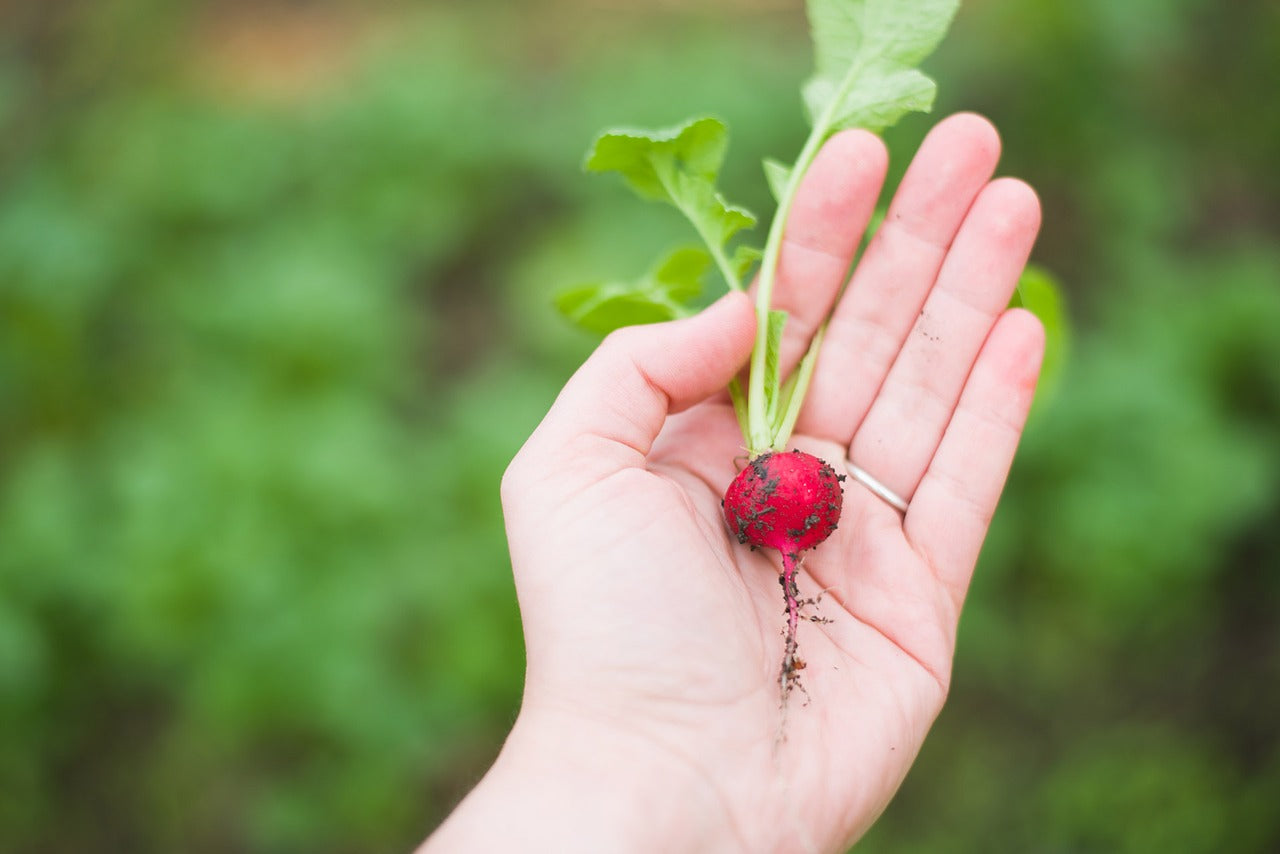Radishes are one of the quickest and easiest vegetables to grow at home. They’re super nutritious too, and very productive! Many people don’t know the whole radish plant is edible, even the greens. The sliced roots add a colorful, spicy pop to a salad, or make a great garnish for any number of dishes. A light sautee takes the fuzzy texture away from the leaves, and makes them tender and tasty, similar to mustard or turnip greens. Radishes are an especially great option for container gardens, since they produce so much in a short time and little space.
The Different Types of Radishes
Radishes come in a rainbow of colors and all shapes and sizes. While all radishes grow relatively quickly, some are especially known for their speed, while others take a little longer to mature. Typically, radishes that have a longer maturity time are more cold hardy and may stay fresh in storage longer. These are the preferred types to plant in late summer for a fall crop, while the quickest-growing types are considered “spring” radishes. That said, all radishes are a cool season crop that can be grown in either spring or fall - there are no hard and fast rules!
Great Radish Varieties to Grow at Home

Sparkler Radish
A classic round, red, spicy radish that’s ready to harvest in just 28 days! Super tasty sliced up in a salad, and couldn’t be easier to grow.

French Breakfast
This beautiful French heirloom radish has an elongated shape and beautiful two-tone red and white color. The “breakfast” part of the name may be a bit of a misnomer. The French don’t typically eat radishes for breakfast - but they have been known to eat sliced radishes on top of buttered baguette. Ever tried it? It may seem like a counter-intuitive serving option, but really, can you go wrong when bread and butter are involved?

Purple Plum
This gorgeous purple radish with a crunchy, mild white interior is ready in a flash, just 25 days from seeding!

Watermelon Radish
Green skin and pink flesh make this unusual radish look just like a watermelon when you cut into it! The roots can be harvested relatively large, at 3-6” in diameter. This is a great choice for a fall radish crop, since the roots will store well into the winter (just don’t forget to cut the tops off before putting them in cool storage!)

Japanese Minowase Daikon
The daikon radish is still a bit unusual in the United States, but it’s long been a staple in Asian cuisines. The long, tapering white roots look more like a parsnip than the round red radishes you might be familiar with, but share the spicy crisp crunch of their relatives. Daikon is traditionally eaten pickled, stir fried, or raw, and is known for its good storage quality. This is the only type of radish that’s probably best to avoid growing in a container - their roots go deep, up to 24 inches!

Halloween Mix
Here’s a fun radish mix to get you in the spooky season mood! An even mix of fall toned roots, including yellow-skinned Helios, Black Spanish Round, White Hailstone, and Purple Plum. If planted in late summer, they’ll be ready by Halloween.

Radish Nutrition Facts
In addition to being beautiful and super easy to grow, radishes are a nutrition-packed crop with a range of health benefits.
Radish Vitamins & Minerals
Radishes contain high levels of multiple antioxidants, along with vitamins C and B6, and minerals like iron, calcium, potassium, and manganese. These substances are known to protect your cells from damage, promote good liver function, and support your general well-being.
Radish Health Benefits
Because radishes are so loaded with good compounds while being low in carbohydrates and calories, they’re a particularly great food for diabetic or pre-diabetic folks who are watching their blood sugar.

Tips for Growing Radishes
Radishes are a cool weather crop that should be direct-sown either early spring or late summer. They prefer full sun, but will tolerate some shade. (Just don’t expect them to mature as quickly if they get less than 6 hours of sun per day.) They do best in loose, well-drained soil that allows their roots to grow freely and doesn’t leave them waterlogged. It’s a good idea to incorporate about 2-3 inches of well-aged compost to your garden bed before planting, as with other root crops. If you know your garden suffers from flea beetles, it might be worth growing your radishes under row cover, but usually radishes grow so fast, few pests have a chance to get to them! Read more on our blog post about how to grow radishes.

|
Article Written by: Leah Smith |
|
About the Author: Leah Smith is the Seed Product Manager at Sow True Seed, where she focuses on adding new varieties to the catalog and ensuring the seed stock is top-notch. Her firsthand experience in farming has given her a deep understanding of cultivating crops while caring for the environment. |



